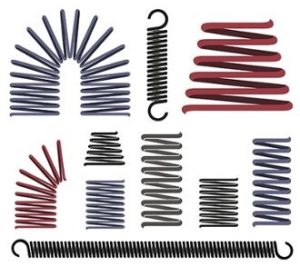 When you’re looking to buy springs, knowing what’s out there for you to choose from can help you understand what you need for the job at hand. The three general categories of springs are used for different applications, and the size, material, coating, and end types will all have an impact on efficiency and durability. Choose the wrong spring for the job and you’ll face costly downtime and frustration. To increase your spring knowledge and make the right choice, check out this complete guide.
When you’re looking to buy springs, knowing what’s out there for you to choose from can help you understand what you need for the job at hand. The three general categories of springs are used for different applications, and the size, material, coating, and end types will all have an impact on efficiency and durability. Choose the wrong spring for the job and you’ll face costly downtime and frustration. To increase your spring knowledge and make the right choice, check out this complete guide.
Compression Spring
The compression spring offers resistance when pushed down with a compressive force. The active coils store and release energy. The load compresses it and makes it shorter while the spring attempts to push back to get to its original length. This energy-efficient open-coil helical spring is the most commonly used metal spring. It can be conical, hourglass, or barrel shaped and custom designs are common. It’s typically fitted into a hole or placed over a rod. It can be wound in a left-hand or right-hand direction and can have varying amounts of coils, which are counted from tip to tip. It can have a closed end, ground ends, or open ends.
Compression springs are found in virtually endless applications, from tiny medical and instrumentation devices to engines, electronics, major appliances, and lawn mowers.
Extension Spring
The helical extension spring performs in the opposite way of the compression spring by extending instead of compressing, and the stress levels are lower than for the compression spring because it doesn’t have a solid stop that prevents overloading. It has loops, eyes or hooks on each end in order to allow the application of a pull force. These ends are attached to other components, and when these components move apart, the spring tries to get back to its original form by bringing them together again. Initial tension keeps the coils closed, which must be overcome before the coils begin to open. The unloaded position is called the free length, while the fully rated extension is known as the extended length, and the full extension is the maximum load. This type of spring not only absorbs and stores energy, but it also creates a resistance to a pulling force.
It’s used in many applications, such as farming machinery, children’s toys, trampolines, garage doors, brakes, and pliers.
Torsion Spring
The torsion spring is used to store rotational energy or apply a torque. As with the extension spring, the ends of the torsion spring are attached to other components. The difference is the spring tries to push back the components to get back to its original shape while the components rotate around the center of it rather than through extension. It statically holds a mechanism in place or stores and releases angular energy. The torsion spring is typically mounted around an arbor or shaft and has to be supported by at least three points.
Torsion springs can be found in clothes pins, window shades, clipboards, hinges, ratchets, and many other applications.
Materials, Coatings, and Surface Treatments
Depending on your application, you can choose from a variety of materials, coating, and surface treatment options. Material selection ranges from ferrous and non-ferrous metals, stainless steel, and alloy steels. Material can also any number of different shapes including round, square, triangular, hexagonal, or just about any shape you can imagine.
Your springs can also be treated with electropolishing, tumbling, shot peening, electroplating, electroless plating, or chemical coatings. The materials you choose will have an impact on the efficiency and durability of your spring while the coating option you choose will be based on the amount of corrosion protection you require and the surface hardness or wear resistance you need.
Belt Tensioner Spring
Learn How We Helped an Automative Parts Manufacturer
Reduce Spring Cost by 20%
